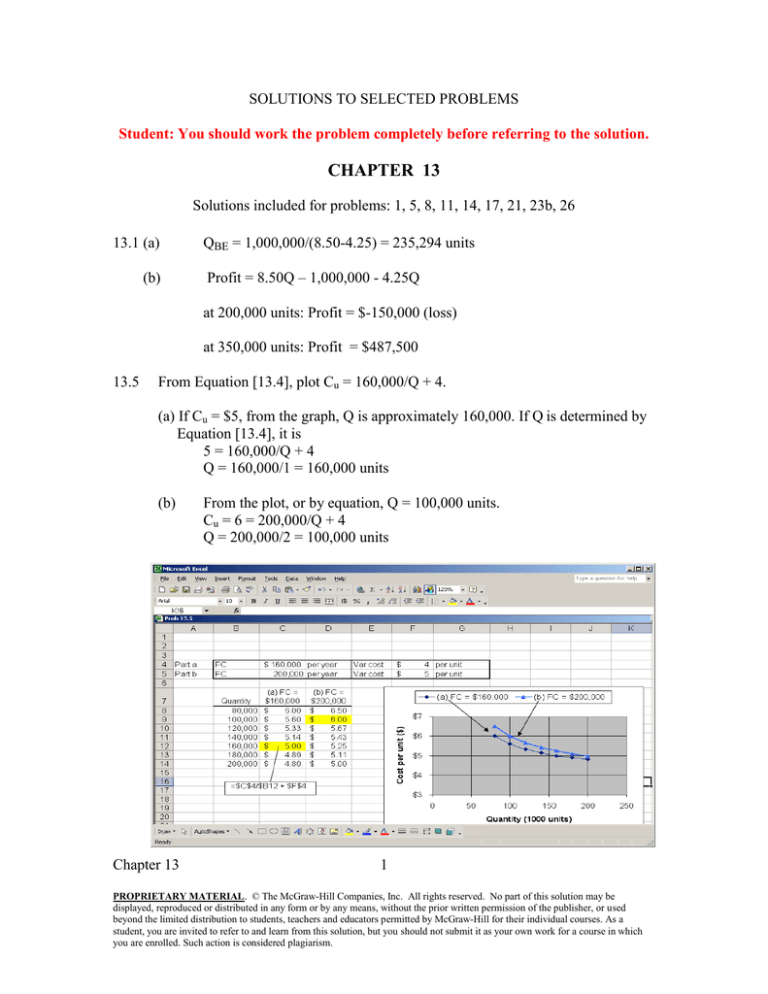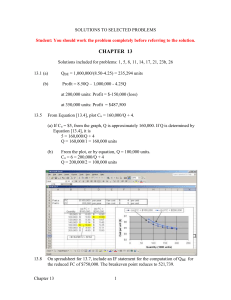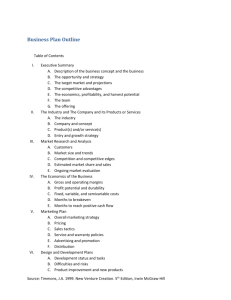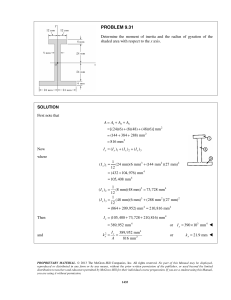
SOLUTIONS TO SELECTED PROBLEMS
Student: You should work the problem completely before referring to the solution.
CHAPTER 13
Solutions included for problems: 1, 5, 8, 11, 14, 17, 21, 23b, 26
13.1 (a)
(b)
QBE = 1,000,000/(8.50-4.25) = 235,294 units
Profit = 8.50Q – 1,000,000 - 4.25Q
at 200,000 units: Profit = $-150,000 (loss)
at 350,000 units: Profit = $487,500
13.5
From Equation [13.4], plot Cu = 160,000/Q + 4.
(a) If Cu = $5, from the graph, Q is approximately 160,000. If Q is determined by
Equation [13.4], it is
5 = 160,000/Q + 4
Q = 160,000/1 = 160,000 units
(b)
Chapter 13
From the plot, or by equation, Q = 100,000 units.
Cu = 6 = 200,000/Q + 4
Q = 200,000/2 = 100,000 units
1
PROPRIETARY MATERIAL. © The McGraw-Hill Companies, Inc. All rights reserved. No part of this solution may be
displayed, reproduced or distributed in any form or by any means, without the prior written permission of the publisher, or used
beyond the limited distribution to students, teachers and educators permitted by McGraw-Hill for their individual courses. As a
student, you are invited to refer to and learn from this solution, but you should not submit it as your own work for a course in which
you are enrolled. Such action is considered plagiarism.
13.8
On spreadsheet for 13.7, include an IF statement for the computation of QBE for
the reduced FC of $750,000. The breakeven point reduces to 521,739.
13.11 FC = $305,000
(a)
(b)
v = $5500/unit
Profit = (r – v)Q – FC
0 = (r – 5500)5000 – 305,000
(r – 5500) = 305,000 / 5000
r = $5561 per unit
Profit = (r – v)Q – FC
500,000 = (r – 5500)8000 – 305,000
(r – 5500) = (500,000 + 305,000) / 8000
r = $5601 per unit
13.14 Let x = hours per year
-800(A/P,10%,3) - (300/2000)x -1.0x = -1,900(A/P,10%,5) - (700/8000)x - 1.0x
-800(0.40211) - 0.15x - 1.0x = -1,900(0.2638) - 0.0875x - 1.0x
x = 2873 hours per year
Chapter 13
2
PROPRIETARY MATERIAL. © The McGraw-Hill Companies, Inc. All rights reserved. No part of this solution may be
displayed, reproduced or distributed in any form or by any means, without the prior written permission of the publisher, or used
beyond the limited distribution to students, teachers and educators permitted by McGraw-Hill for their individual courses. As a
student, you are invited to refer to and learn from this solution, but you should not submit it as your own work for a course in which
you are enrolled. Such action is considered plagiarism.
13.17 (a) Let x = breakeven days per year. Use annual worth analysis.
-125,000(A/P,12%,8) + 5,000(A/F,12%,8) - 2,000 - 40x = -45(125 +20x)
-125,000(0.2013) + 5,000(0.0813) - 2,000 - 40x = -5625 –900x
x = 24.6 days per year
(b) Since 75 > 24.6 days, buy. Annual cost is $-29,756
13.21 Let x = yards per year to breakeven
(a) Solution by hand
-40,000(A/P,8%,10) - 2,000 -(30/2500)x = - [6(14)/2500]x
-40,000(0.14903) - 2,000 - 0.012x = -0.0336x
x = 368,574 yards per year
(b) Solution by computer: There are many Excel set-ups to work the problem.
One is: Enter the parameters for each alternative, including some number of
yards per year as a guess. Use SOLVER to force the breakeven equation to
equal 0, with a constraint that total yardage be the same for both alternatives.
Chapter 13
3
PROPRIETARY MATERIAL. © The McGraw-Hill Companies, Inc. All rights reserved. No part of this solution may be
displayed, reproduced or distributed in any form or by any means, without the prior written permission of the publisher, or used
beyond the limited distribution to students, teachers and educators permitted by McGraw-Hill for their individual courses. As a
student, you are invited to refer to and learn from this solution, but you should not submit it as your own work for a course in which
you are enrolled. Such action is considered plagiarism.
13.23 (b) Enter the cash flows and develop the PW relations for each column. Breakeven
is between 15 and 16 years. Selling price is estimated to be between $206,250
and $210,000.
Breakeven
occurs here
13.26 (a) By hand: Let P = first cost of sandblasting. Equate the PW of painting each 4
years to PW of sandblasting each 10 years, up to 38 years.
PW of painting
PWp = -2,800 - 3,360(P/F,10%,4) - 4,032(P/F,10%,8) - 4,838(P/F,10%12) –
5,806(P/F,10%,16) - 6,967(P/F,10%,20) -8,361(P/F,10%,24) –
10,033(P/F,10%,28) - 12,039(P/F,10%,32) -14,447(P/F,10%,36)
= $-13,397
Chapter 13
4
PROPRIETARY MATERIAL. © The McGraw-Hill Companies, Inc. All rights reserved. No part of this solution may be
displayed, reproduced or distributed in any form or by any means, without the prior written permission of the publisher, or used
beyond the limited distribution to students, teachers and educators permitted by McGraw-Hill for their individual courses. As a
student, you are invited to refer to and learn from this solution, but you should not submit it as your own work for a course in which
you are enrolled. Such action is considered plagiarism.
13.26 (cont)
PW of sandblasting
PWs = -P - 1.4P(P/F,10%,10) - 1.96P(P/F,10%,20) - 2.74P(P/F,10%,30)
-P[1 + 1.4(0.3855) + 1.96(0.1486) + 2.74(0.0573)]
= -1.988P
Equate PW relations to obtain P = $6,739
(b) By computer: Enter the periodic costs. Use SOLVER to find breakeven
at P = $6739.
(c) Change MARR to 30% and 20%, respectively, and re-SOLVER to get:
30%: P = -$7133
20%: P = -$7546
Chapter 13
5
PROPRIETARY MATERIAL. © The McGraw-Hill Companies, Inc. All rights reserved. No part of this solution may be
displayed, reproduced or distributed in any form or by any means, without the prior written permission of the publisher, or used
beyond the limited distribution to students, teachers and educators permitted by McGraw-Hill for their individual courses. As a
student, you are invited to refer to and learn from this solution, but you should not submit it as your own work for a course in which
you are enrolled. Such action is considered plagiarism.





